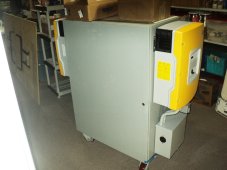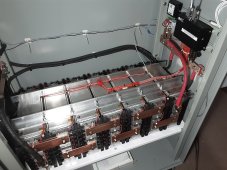Greetings all,
On the trail for the latest experience / info on expanding an existing off-grid backup system.
Current system is a paired set of Sunny Boy SI 6048-US-10s with battery backup and generator (DC Solar trailer setup). This goes into 2 separate panels via transfer switches - one to the house and one to the garage.
I would like to add a grid-tied portion to the system that can be used either connected to the grid or the existing off-grid Sunny Boys. Looking to add 6-14kw of PV depending on costs/etc.
In a perfect world I would primarily operate the grid-tied part of the system in traditional fashion - tied to the (real) grid.
In an extended outage, I would like to utilize the grid-tied portion of the system with the off-grid part of the system to increase available power via solar.
My initial looks make be believe the Sunny Island inverter would do the trick, but is limited to a maximum size of 7.7kw. Would be nice if I could go larger, but this seems to be the top-end of the KW range for Sunny Boy AC coupled inverters, and it doesn't look like you can do multiple SIs together. The only other "limitation" I'm finding is the 600vdc system voltage vs 1000 or 1500vdc. This is somewhat offset by having 3 separate MPPT inputs, but becomes more limiting on overall panel wattage and string size. 10A seems to be the max string amperage as well, limiting panel size to about 350-400w.
I also started looking at going with micro-inverters on the grid-tied portion, but after doing some reading it looks like the Enphase IQ7s have some teething problems as well.
I like the idea of sticking with the SMA/Sunny products as it seems they would at least >potentially< operate better together than products from other vendors.
Questions:
1) Does anyone have AC coupled experience they can share with respect to the issues above?
2) Are there other/better grid-tied inverter options to look at that would AC couple to the Sunny Boy 6048s?
3) Any other tidbits of wisdom to consider?
Cheers,
Rob
On the trail for the latest experience / info on expanding an existing off-grid backup system.
Current system is a paired set of Sunny Boy SI 6048-US-10s with battery backup and generator (DC Solar trailer setup). This goes into 2 separate panels via transfer switches - one to the house and one to the garage.
I would like to add a grid-tied portion to the system that can be used either connected to the grid or the existing off-grid Sunny Boys. Looking to add 6-14kw of PV depending on costs/etc.
In a perfect world I would primarily operate the grid-tied part of the system in traditional fashion - tied to the (real) grid.
In an extended outage, I would like to utilize the grid-tied portion of the system with the off-grid part of the system to increase available power via solar.
My initial looks make be believe the Sunny Island inverter would do the trick, but is limited to a maximum size of 7.7kw. Would be nice if I could go larger, but this seems to be the top-end of the KW range for Sunny Boy AC coupled inverters, and it doesn't look like you can do multiple SIs together. The only other "limitation" I'm finding is the 600vdc system voltage vs 1000 or 1500vdc. This is somewhat offset by having 3 separate MPPT inputs, but becomes more limiting on overall panel wattage and string size. 10A seems to be the max string amperage as well, limiting panel size to about 350-400w.
I also started looking at going with micro-inverters on the grid-tied portion, but after doing some reading it looks like the Enphase IQ7s have some teething problems as well.
I like the idea of sticking with the SMA/Sunny products as it seems they would at least >potentially< operate better together than products from other vendors.
Questions:
1) Does anyone have AC coupled experience they can share with respect to the issues above?
2) Are there other/better grid-tied inverter options to look at that would AC couple to the Sunny Boy 6048s?
3) Any other tidbits of wisdom to consider?
Cheers,
Rob





